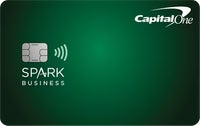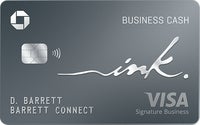Capital One Spark Cash Plus vs. Chase Ink Business Cash

The Bankrate promise
At Bankrate we strive to help you make smarter financial decisions. While we adhere to strict , this post may contain references to products from our partners. Here's an explanation for . The content on this page is accurate as of the posting date; however, some of the offers mentioned may have expired. Terms apply to the offers listed on this page. Any opinions, analyses, reviews or recommendations expressed in this article are those of the author’s alone, and have not been reviewed, approved or otherwise endorsed by any card issuer.
Key takeaways
- The Capital One Spark Cash Plus is a better fit for high spenders ($200,000 or more per year) who don’t mind paying an annual fee and are able to pay their balance in full each month.
- The Ink Business Cash® Credit Card might work better for small business owners who frequently spend in the card’s bonus categories, don’t want to pay an annual fee and want the option to carry a balance.
Businesses have diverse needs, so it should be no surprise that there’s a lot of variety when it comes to the features and rewards of the many business credit cards on the market. Before you choose a business card, it’s always a good idea to see what’s unique about it and how it stacks up against competitors in the field.
Here, we compare two you may want to consider: the Capital One Spark Cash Plus and the Ink Business Cash® Credit Card from Chase. The Capital One Spark Cash Plus is a charge card without a preset spending limit that offers a flat rate of cash back on all purchases, while the Ink Business Cash is a standard credit card offering boosted cash back rewards rates on several common business spending categories. So, which is right for your business? We’ll help you decide.
Main details
| Cards | Capital One Spark Cash Plus | Ink Business Cash Credit Card |
|---|---|---|
| Welcome bonus | Earn a one-time cash bonus of $1,200 once you spend $30,000 in the first 3 months from account opening | Earn up to $750 bonus cash back: earn $350 cash back after spending $3,000 in purchases in the first 3 months and an additional $400 after spending $6,000 in the first 6 months from account opening |
| Rewards rate |
|
|
| Intro APR | N/A | 0% intro APR on purchases for the first 12 months, then a variable APR of 18.49% to 24.49% |
| Annual fee | $150 (can be refunded every year you spend at least $150,000) | $0 |
Spark Cash Plus vs. Ink Business Cash highlights
These card highlights can help you decide which card is better for your business.

Spark Cash Plus
-
The Spark Cash Plus offers a welcome bonus that can be quite lucrative if you’re able to reach the spending threshold. It pays a one-time cash bonus of $1,200 once you spend $30,000 in the first three months from account opening.
On the other hand, the Ink Business Cash provides a maximum bonus of $750 if you spend a total of $6,000 on purchases within the first six months. The bonus has two parts — $350 when you spend $3,000 in the first three months, and an additional $400 for $6,000 of cumulative spending in the first six months.
That gives you a better return on your spending than the Spark Cash Plus welcome bonus, and it’s not bad in comparison to other small business cards. If you’re not able to reach $6,000 of spending in six months, you can still get part of the Ink Business Cash’s welcome bonus if you can spend $3,000 in three months. That’s different from the Spark Cash Plus’s all-or-nothing deal.
The Spark Cash Plus wins for its objectively higher welcome bonus, but only if your business can meet the $30,000 spending requirement. If not, then the Ink Business Cash will offer you a better welcome bonus.

Ink Business Cash
-
The Ink Business Cash and Capital One Spark Cash Plus have two completely different rewards systems, and which one is more rewarding will depend on your business’s spending patterns.
However, we give this category to the Ink Business Cash simply because it has more ways to earn boosted rewards than the Spark Cash Plus.
The Ink Business Cash offers:
- 5 percent cash back at office supply stores and on internet, cable and phone services (on up to $25,000 in combined purchases per account anniversary year, then 1 percent).
- 2 percent cash back at gas stations and restaurants (on up to $25,000 in combined purchases per account anniversary year, then 1 percent)
- 1 percent on all other purchases
If you spend the full $25,000 on purchases in those 5 percent bonus categories, you’ll earn $1,250 in rewards. In comparison, the Spark Cash Plus offers:
- 5 percent cash back on hotels and rental cars booked through Capital One Travel
- 2 percent cash back on all other purchases
So if you spent $25,000 the same way you did with the Ink Business Cash, you would earn $500 in rewards on those purchases. Because the Ink Business Cash also offers 2 percent back on the first $25,000 in combined spending at gas stations and restaurants each year, it’s on par with the Spark Cash Plus for those categories. But if you spend that $25,000 on hotels and rental cars through Capital One Travel instead, you’d earn $1,250 with the Spark Cash Plus but only $250 with the Ink Business Cash at its 1 percent rate.
Ultimately, both cards have the potential to be more rewarding than the other, depending on the circumstances. If you spend a significant amount each year at office supply stores and on internet, cable and phone services, then you can earn a higher rewards rate with the Ink Business Cash. If your spending is mostly in miscellaneous categories, or if you plan on using the Capital One Travel portal pretty often, then the Spark Cash Plus might be a better fit.

Ink Business Cash
-
The Ink Business Cash doesn’t charge an annual fee, while the Spark Cash Plus charges $150 per year for card membership. However, you can get that annual fee refunded each year you spend at least $150,000 on the card.
If you can’t reach the spending requirement for the annual fee refund on the Spark Cash Plus and you’re not sure whether your rewards earnings will be sufficient to recoup the annual fee, you might prefer the Ink Business Cash.

Spark Cash Plus
-
International travelers may want to choose the Spark Cash Plus, which doesn’t impose a fee on purchases made outside of the U.S. The Ink Business Cash charges a 3 percent fee on foreign transactions, so it’s not an ideal option for trips outside of the country or if you make purchases from vendors in foreign currency.

Ink Business Cash
-
The clear winner here is the Ink Business Cash Credit Card — and that’s because the Spark Cash Plus doesn’t offer an introductory APR promotion at all.
With the Ink Business Cash, you can take advantage of a 0 percent introductory APR on purchases for 12 months from account opening. After that, the card’s variable APR of 18.49 percent to 24.49 percent will kick in on whatever balance is left on the card.
This offer can be especially helpful if you’re planning on using your card to fund a large purchase or cover high startup costs.
Which card earns the most?
Both of these cards can deliver plenty of rewards, but the one that earns more will depend on how much you use the card and what you’re buying. If you’re running a small online company and devote a large chunk of your budget to office supplies and telecommunications each year, then the Ink Business Cash might come out ahead.
But if you’re running a large enterprise with lots of expenses in other categories, you might benefit more from the Spark Cash Plus due to its welcome bonus potential and unlimited 2 percent cash back rate on all purchases. Here’s a spending example to illustrate the differences in rewards you might see between each card:
Spark Cash Plus vs. Ink Business Cash spending example
Let’s say you spend $4,000 a month (or $48,000 a year) with your business card. Suppose the spending breakdown is like this:
- $500 a month on office supplies
- $1,000 a month on internet, cable and phone services
- $400 a month at gas stations
- $400 a month at restaurants
- $1,700 a month on other spending
For the Spark Cash Plus, your spending in the first three months would total $12,000. That wouldn’t be enough to earn the welcome bonus, which requires spending $30,000 in the first 3 months.
But since the Spark Cash Plus provides an unlimited 2 percent cash back on all spending, your $48,000 in annual purchases would earn $960 in rewards. $48,000 doesn’t meet the required annual spending amount to get the annual fee refunded, so you’ll net $810 in earnings after taking the $150 membership fee into account.
Now, let’s run the numbers for the Ink Business Cash. Because you spent more than $6,000 total in the first 6 months, you’ll earn the full $750 welcome bonus. The rest of your spending and earning breakdown looks like this:
- $18,000 total for the year on office supplies, internet, cable and phone bills, which is less than the $25,000 annual spending cap on the 5 percent cash back rate in those categories. This will net you 5 percent cash back on the entire amount, which comes out to $900.
- $9,600 total for the year in gas station and restaurant spending, which is also below the $25,000 annual spending cap on the 2 percent cash back rate in those categories. This will net you 2 percent cash back on the entire amount, which comes out to $192.
- $20,400 in additional annual spending, which earns cash back at a 1 percent rate. This will give you $204 in cash back.
Add all the cash back together, and you’ll earn a total of $1,296 in rewards from spending, plus $750 from the welcome bonus for a total of $2,046 in cash back during the first year. Since the Ink Business Cash doesn’t charge an annual fee, you don’t need to subtract the fee from your earnings.
That comes out to $1,236 more in rewards than the Spark Cash Plus (after subtracting the annual fee), so the Ink Business Cash takes the lead in this example.
Why should you get the Spark Cash Plus?
The Spark Cash Plus could be a great choice for business owners who have a lot of overhead or regularly need to make expensive business purchases since its welcome bonus is geared toward higher spenders. Plus, it provides a $150 annual fee refund to cardholders who spend at least $150,000 each year. Here are some other reasons to get the card:
Additional benefits
As a charge card, the Spark Cash Plus doesn’t impose a preset spend limit, which could appeal to entrepreneurs who want a personalized approach that adjusts to their spending patterns. However, no preset spending limit doesn’t mean unlimited spending — instead, you have a flexible amount of purchasing power that’s unique to your card. According to the issuer, “The purchasing power adapts based on factors such as payment history, spending behavior, credit profile and other factors, which may be external.”
The Spark Cash Plus benefits include the option to appoint an account manager, order free employee cards and set spending limits and purchase reviews for employees. The card also offers bookkeeping tools such as itemized year-end summaries, lists of recurring transactions and integration with accounting software. Plus, you can get virtual card numbers for greater security when buying things online, and you can lock your card or an employee’s card if it’s lost or stolen. The Spark Cash Plus also includes extended warranty protection for eligible items purchased with the card, as well as roadside assistance and other benefits.
Redemption options
You can redeem rewards for a statement credit or check when you want to cash out your rewards, or you can set up automatic redemptions so you get your earnings on a specific date each year or when your balance reaches a certain amount. You’ll also have the option to redeem rewards for gift cards, credits for past purchases, travel booked through Capital One Travel or Amazon and PayPal purchases. However, redemption rates for some of these options may be different from what you’d get if you redeemed for cash.
Recommended credit score
You’ll need excellent credit to qualify for this card, which is a FICO score of 740 to 850.
Why should you get the Ink Business Cash?
The Ink Business Cash allows you to carry a balance from one month to the next — though you’ll have to pay interest if you do so outside of the card’s introductory APR period. That might make this card a better choice for business owners whose income rises and falls unpredictably.
The lack of an annual fee might also be attractive for those who don’t know what their spending will look like over the year and aren’t sure whether they’ll earn enough rewards to offset the price of card membership. And if your business spends a lot in the Ink Business Cash’s bonus categories, the rewards on this card can be lucrative.
Here are some other reasons this card might be right for you:
Additional benefits
The Ink Business Cash offers many benefits, including free employee cards and the ability to transfer records to accounting software, which could make tax prep easier. Cardholders will also get benefits like:
- Purchase protection against damage or theft for 120 days (up to $10,000 per claim and $50,000 per account)
- Extended warranties for eligible items
- Travel and emergency assistance services
- Roadside dispatch service
- An auto rental collision damage waiver
Redemption options
With this card, you can redeem rewards for cash back (in the form of statement credits or direct deposits), gift cards, travel through the Chase Travel portal or paying with points at select retailers. If you pay for purchases at participating retailers, however, you may not get a 1:1 redemption rate. You can visit the Chase Travel portal to book airfare, hotel stays, car rentals, cruises or travel experiences. Or, you can pool your points with a premium Chase card in the Chase Ultimate Rewards program, such as the Chase Sapphire Preferred® Card, for the ability to transfer points to airline and hotel partners and potentially get more value for your rewards.
Recommended credit score
You should have good to excellent credit — or a FICO score of 670 to 850 — for the best chance of qualifying for this card.
The bottom line
Whether the Capital One Spark Cash Plus or the Chase Ink Business Cash is better for you comes down to how much you plan to spend, what your top spending categories are and whether you need an introductory APR offer for short-term, interest-free financing.
If you want a charge card without a preset spend limit, or if the majority of your business spending falls outside of typical business credit card bonus categories, the Spark Cash Plus could be right for you. The Spark Cash Plus offers a lot of value for a $150 annual fee, especially if you can comfortably spend $30,000 within three months to earn the welcome bonus. On the other hand, if your company has more modest spending levels, or if your primary business expenses fall into one of the Ink Business Cash’s 5 percent cash back categories, you’re likely better off with the Ink Business Cash.
Before you make your decision, however, compare these cards to the top business credit cards on the market. Bankrate’s card comparison tool can help you decide how they stack up against each other.

